If you frequent the gym, chances are you’ve seen fellow gym rats sporting stretchy bands during their workouts. From fit mamas to competitive powerlifters, resistance bands offer amazing benefits for everyone interested in stepping up their fitness routine. Resistance bands are lightweight strips of elastic used to stimulate both muscular stretching and contraction. You can use resistance bands for everything from dynamically warming up your hips prior to your squat workout to getting your glutes burning between weighted exercises. And while you can achieve these results with other equipment, what differentiates resistance bands is their effectiveness as a training approach of their own. That’s right, ladies: Resistance bands offer a workout solution that meshes with long work days, frequent travel, and even post-injury rehabilitation. Read on to learn how just a few bands can afford you a killer workout that will progress you toward your health and fitness goals.
Why reach for the band?
Training with resistance bands has the potential to help individuals comprehensively improve their performance. Resistance band exercises correspond to a broad range of goals and circumstances and help you develop diverse capabilities. They do so by incorporating numerous fundamental training aspects during any given session—from flexibility, strength, and power, to core isolation, fat loss, cardiovascular activity, mobility, balance, coordination, agility, and speed. The simple structure of resistance band exercise allows for countless objectives to be addressed efficiently. According to Dave Schmitz, physical therapist, personal trainer, and founder of Resistance Band Training, resistance bands can be used to develop both functional strength and metabolic conditioning protocols. The resistance created when working with bands is vastly different than the resistance of traditional dumbbells and barbells. Instead of providing constant resistance throughout an entire movement, resistance bands leverage ascending resistance. As the range of motion increases, so too does the work output necessary to complete the exercise. This type of resistance also allows the velocity of any given movement to change and accelerate, which is how the body adapts to create improvements in power. These neurological modifications result in a somatic understanding and ability to use force to generate power, which can translate to a wide variety of daily activities.
Types of Resistance Bands
Resistance bands vary not only in type, but also in size and shape. Some even feature handles and loops that make certain movements easier. Consider which of the following will work best for you as you develop your own resistance band regimen.
Therapy Band
Therapy bands are most often used for rehabilitation-focused exercises. These have a wide, flat surface and are about 4 feet in length.
Compact Band
Like therapy bands, compact bands are also about 4 feet in length, but are tubular rather than flat and typically have a handle attached to each end. Compact resistance bands can be used for both upper and lower body movements, depending on placement (which we delve into below!).
Fit-Loop Band
Fit-loop bands are similar to therapy bands in that they lay flat. That said, they’re looped rather than being a single strip of elastic. Fit-loop resistance bands are best used for lower body movements. Hello, shapely glutes! Fit-loop resistance bands can range from 4 inches to 2 feet in length, and you’ll make your selection depending on your desired level of difficulty.
Figure-8 Band
Figure-8 resistance bands have two plastic handles connected by a tube that’s the shape of a figure-8. The two handles on a figure-8 resistance band makes it especially useful for upper body movements.
Ring Resistance Band
Like figure-8 resistance bands, ring resistance bands are tubular-shaped with two handles. This band is continuous in its construction, thus the comparison to a ring. That said, ring resistance bands are shorter—having, on average, a 1 foot circumference. The handles on ring resistance bands are soft and flexible, as opposed to the plastic handles characteristically seen on figure-8 bands. These bands are often used for lower body exercises, but are best for regimens that diverge from those typically performed with fit loop or compact resistance bands.
Lateral Resistance Band
A lateral resistance band is a single strip of tubular elastic. It has Velcro cuffs on each end that are attached to the ankles for lower body exercises. These bands are especially useful for movements that target the hips and thighs. Resistance bands comes in different colors, which represent different tensions and levels of resistance. Many brands code their resistance bands, and it takes nothing more than a quick glance to ensure you’re buying the level of resistance best fit for your needs. No matter what type of band you settle on, it’s best to buy several different resistance levels to ensure you’re working each body part at your greatest intensity. For example, a band meant for your lower body will need a bit more tension than one used for your upper body.
Breaking a Sweat
For a total body workout, combine the following exercises in a band-based routine:
Front Squat
Targets: Quadriceps, Hamstrings, Glutes, Core
Reach For: A Compact Band
Rep + Set Scheme: 3 to 4 sets of 12 to 15 reps
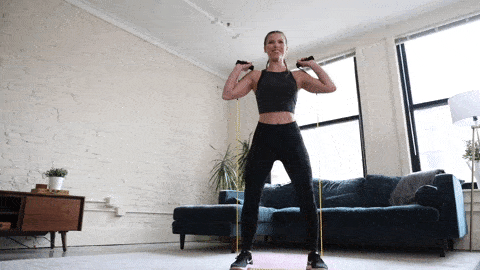
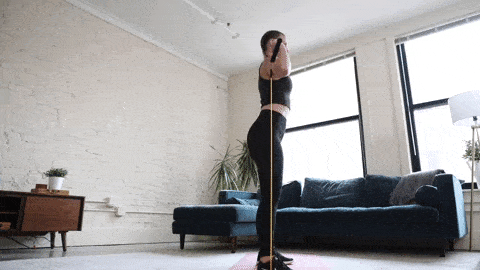 Assume a firm stance with your feet about shoulder-width apart and the middle of the band secured beneath them. Your shoulders should be retracted, your core should be engaged, and your chin should be in a neutral position. Hold one handle of the band in each hand and bring the top of each band around your shoulders . Your arms will be in what’s called the front rack position. Lower into a squat, pushing your bum backward as you imagine yourself sitting back into a chair. Rise back to standing and repeat.
Assume a firm stance with your feet about shoulder-width apart and the middle of the band secured beneath them. Your shoulders should be retracted, your core should be engaged, and your chin should be in a neutral position. Hold one handle of the band in each hand and bring the top of each band around your shoulders . Your arms will be in what’s called the front rack position. Lower into a squat, pushing your bum backward as you imagine yourself sitting back into a chair. Rise back to standing and repeat.
Squat + Press
Targets: Full Body
Reach For: A Compact Band
Rep + Set Scheme: 3 to 4 sets of 12 to 15 reps
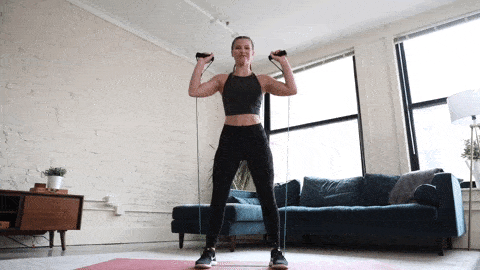
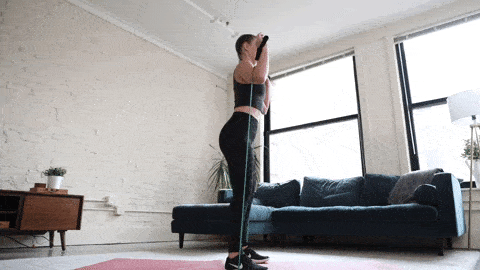 Assume a firm stance with your feet about shoulder-width apart and the middle of the band secured beneath them. Your shoulders should be retracted, your core should be engaged, and your chin should be in a neutral position. Hold one handle of the band in each hand. Hold your arms at shoulder level as if you’re about to initiate the press. Lower into a squat, pushing your bum backward as you imagine yourself sitting back into a chair. In the bottommost position, your thighs should be parallel with the floor. Be sure to keep your hands at shoulder-height. Slowly raise to standing, pressing the handles into the air as you stand. Finish by bringing your arms back down to shoulder-height and repeat.
Assume a firm stance with your feet about shoulder-width apart and the middle of the band secured beneath them. Your shoulders should be retracted, your core should be engaged, and your chin should be in a neutral position. Hold one handle of the band in each hand. Hold your arms at shoulder level as if you’re about to initiate the press. Lower into a squat, pushing your bum backward as you imagine yourself sitting back into a chair. In the bottommost position, your thighs should be parallel with the floor. Be sure to keep your hands at shoulder-height. Slowly raise to standing, pressing the handles into the air as you stand. Finish by bringing your arms back down to shoulder-height and repeat.
Lying Glute Bridge
Targets: Glutes, Hamstrings, Quadriceps, Core
Reach For: A Fit-Loop Resistance Band
Rep + Set Scheme: 3 to 4 sets of 12 to 15 reps
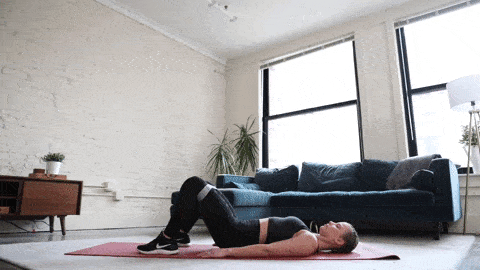 Lie on your back with your knees bent and your feet flat on the floor. You should be able to brush your heels with your fingertips. Position your band just above your knees. Pressing through your heels, drive into a bridge position by raising your hips and bum off the floor. Focus on squeezing your glutes rather than hyperextending your back. Keep your shoulders and neck anchored to the floor. As you raise your lower body, push your legs against the band to separate them further, extending until you feel the tightest resistance in your glutes. Return your legs to center and return your bum to the ground. Repeat.
Lie on your back with your knees bent and your feet flat on the floor. You should be able to brush your heels with your fingertips. Position your band just above your knees. Pressing through your heels, drive into a bridge position by raising your hips and bum off the floor. Focus on squeezing your glutes rather than hyperextending your back. Keep your shoulders and neck anchored to the floor. As you raise your lower body, push your legs against the band to separate them further, extending until you feel the tightest resistance in your glutes. Return your legs to center and return your bum to the ground. Repeat.
Side-Lying Clamshell
Targets: Glutes, Quadriceps, Lumbar
Reach For: A Fit-Loop Resistance Band
Rep + Set Scheme: 3 to 4 sets of 12 to 15 reps per side
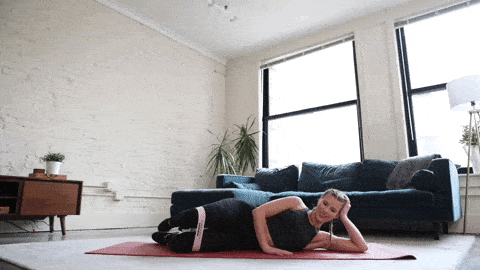 Lie on your side with your hips and knees bent to 90 degrees. Loop the band around your legs, just above your knees. Pull your knees apart, focusing on squeezing your glutes to drive through the movement. Keep your hips square and facing forward. Hold the final position for 2 to 5 seconds. Slowly close your legs and return your knees to the starting position. Repeat.
Lie on your side with your hips and knees bent to 90 degrees. Loop the band around your legs, just above your knees. Pull your knees apart, focusing on squeezing your glutes to drive through the movement. Keep your hips square and facing forward. Hold the final position for 2 to 5 seconds. Slowly close your legs and return your knees to the starting position. Repeat.
Band Pull-Apart
Targets: Chest, Triceps, Rhomboids
Reach For: A Compact or Figure-8 Resistance Band
Rep + Set Scheme: 3 to 4 sets of 12 to 15 reps
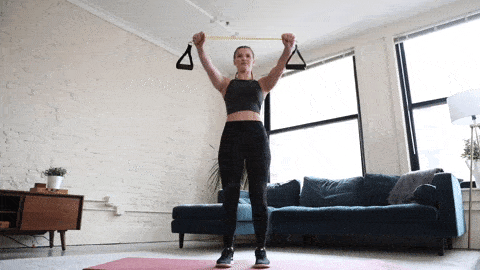
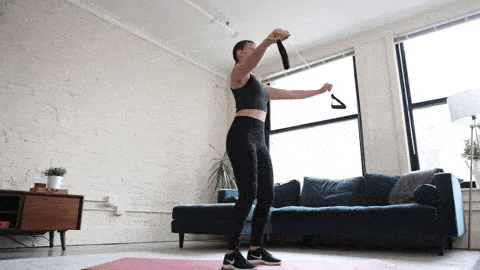 Stand with your feet shoulder-width apart. Your shoulders should be retracted, your core should be engaged, and your chin should be in a neutral position. Hold one handle or end of the band in each hand with an overhand grip with your arms fully extended in front of your body. Imagine zombie arms! They should be parallel to the ground. Pull the band apart by squeezing your shoulder blades together until the band brushes your chest. Slowly return to the starting position and repeat.
Stand with your feet shoulder-width apart. Your shoulders should be retracted, your core should be engaged, and your chin should be in a neutral position. Hold one handle or end of the band in each hand with an overhand grip with your arms fully extended in front of your body. Imagine zombie arms! They should be parallel to the ground. Pull the band apart by squeezing your shoulder blades together until the band brushes your chest. Slowly return to the starting position and repeat.
Bent-Over Row
Targets: Back, Biceps
Reach For: A Compact Band
Rep + Set Scheme: 3 to 4 sets of 12 to 15 reps
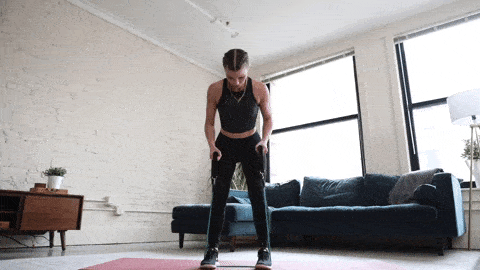
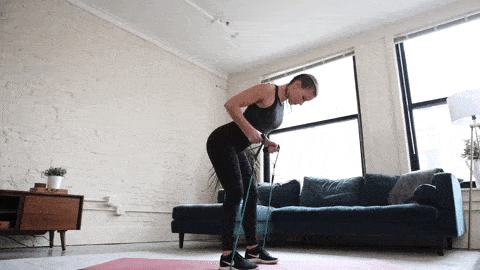 Assume a firm stance with your feet about shoulder-width apart and the middle of the band secured beneath them. Your shoulders should be retracted, your core should be engaged, and your chin should be in a neutral position. Hold one handle of the band in each hand and fully extend your arms. Your palms should be rotated in and facing each other. Hinge at the hips until your trunk is nearly parallel with the ground. Your arms should be reaching toward your feet. Keeping your core engaged and shoulders retracted, pull each band toward your abdomen. Squeeze your shoulder blades together and draw your elbows back until your hand approach your hips. Return to the starting position and repeat.
Assume a firm stance with your feet about shoulder-width apart and the middle of the band secured beneath them. Your shoulders should be retracted, your core should be engaged, and your chin should be in a neutral position. Hold one handle of the band in each hand and fully extend your arms. Your palms should be rotated in and facing each other. Hinge at the hips until your trunk is nearly parallel with the ground. Your arms should be reaching toward your feet. Keeping your core engaged and shoulders retracted, pull each band toward your abdomen. Squeeze your shoulder blades together and draw your elbows back until your hand approach your hips. Return to the starting position and repeat.
Upright Row
Targets: Shoulders, Traps
Reach For: A Compact Band
Rep + Set Scheme: 3 to 4 sets of 12 to 15 reps
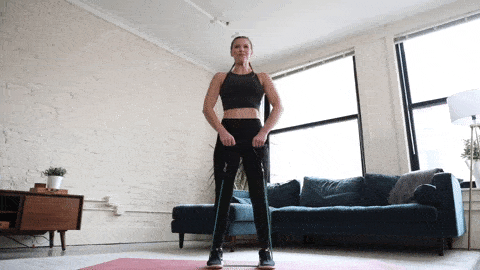
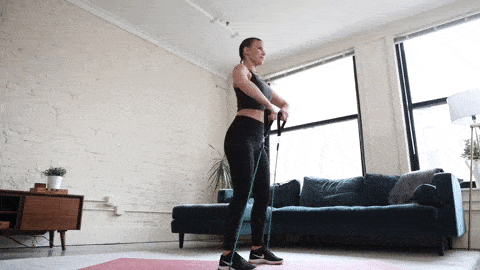 Stand in a firm stance with your feet about shoulder-width apart and the middle of the band secured beneath them. Your shoulders should be retracted, your core should be engaged, and your chin should be in a neutral position. Hold one handle of the band in each hand with an overhand grip. Keep your hands close together and your arms fully extended. This is your official starting position. To perform the movement, lift your hands toward the ceiling while keeping in overhand grip. Raise your hands to shoulder height. Your elbows should be pointing out and your shoulders should not hike up to your ears. Return the band to the starting position and repeat.
Stand in a firm stance with your feet about shoulder-width apart and the middle of the band secured beneath them. Your shoulders should be retracted, your core should be engaged, and your chin should be in a neutral position. Hold one handle of the band in each hand with an overhand grip. Keep your hands close together and your arms fully extended. This is your official starting position. To perform the movement, lift your hands toward the ceiling while keeping in overhand grip. Raise your hands to shoulder height. Your elbows should be pointing out and your shoulders should not hike up to your ears. Return the band to the starting position and repeat.
Pallof Press
Targets: Full Body
Reach For: A Compact Band
Rep + Set Scheme: 3 to 4 sets of 12 to 15 reps per side
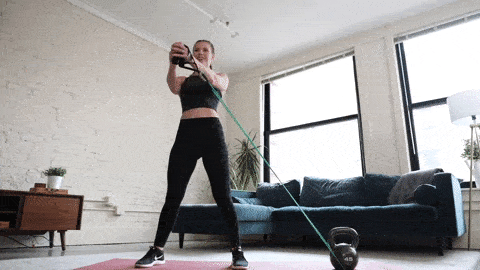
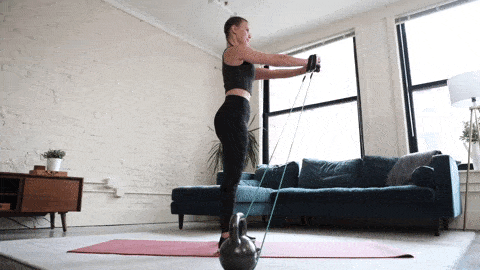 Loop or attach the middle of the band to a fixed object. Stand in line with and perpendicular to the chosen object. Your stance should be firm with your feet about shoulder-width apart. Your shoulders should be retracted, your core should be engaged, and your chin should be in a neutral position. Hold one handle of the band in each hand with an overhand grip. With bent elbows, bring your hands toward your midline until they’re directly in front of (or even brushing!) your chest. Extend your arms and push the band straight out in front of your body. Keep your entire body in s straight line—no rotation at the hips or trunk! Imagine you’re holding a plank, with nothing but your arms moving. Pause with your arms fully extended for 3 seconds. Return the band to the starting position with your hands at your chest and repeat.
Loop or attach the middle of the band to a fixed object. Stand in line with and perpendicular to the chosen object. Your stance should be firm with your feet about shoulder-width apart. Your shoulders should be retracted, your core should be engaged, and your chin should be in a neutral position. Hold one handle of the band in each hand with an overhand grip. With bent elbows, bring your hands toward your midline until they’re directly in front of (or even brushing!) your chest. Extend your arms and push the band straight out in front of your body. Keep your entire body in s straight line—no rotation at the hips or trunk! Imagine you’re holding a plank, with nothing but your arms moving. Pause with your arms fully extended for 3 seconds. Return the band to the starting position with your hands at your chest and repeat.
Bicep Curl
Targets: Biceps
Reach For: A Compact Band
Rep + Set Scheme: 3 to 4 sets of 12 to 15 reps
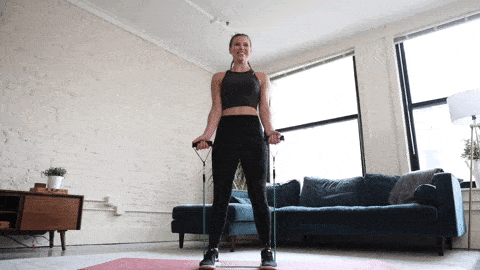
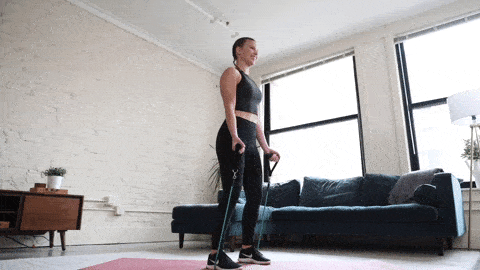 Assume a firm stance with your feet about shoulder-width apart and the middle of the band secured beneath them. Your shoulders should be retracted, your core should be engaged, and your chin should be in a neutral position. Hold one handle of the band in each hand with an underhand grip. Your arms should be fully extended in front of your body, with your hands resting outside of the hips. Lift the handles to about chin height, or wherever your arms are bent into a complete curl. Your elbows shouldn’t leave the sides of your body and should remain pointing downward. Return the band to the starting position and repeat.
Assume a firm stance with your feet about shoulder-width apart and the middle of the band secured beneath them. Your shoulders should be retracted, your core should be engaged, and your chin should be in a neutral position. Hold one handle of the band in each hand with an underhand grip. Your arms should be fully extended in front of your body, with your hands resting outside of the hips. Lift the handles to about chin height, or wherever your arms are bent into a complete curl. Your elbows shouldn’t leave the sides of your body and should remain pointing downward. Return the band to the starting position and repeat.
Overhead Tricep Extension
Targets: Tricept
Reach For: A Compact Band
Rep + Set Scheme: 3 to 4 sets of 12 to 15 reps
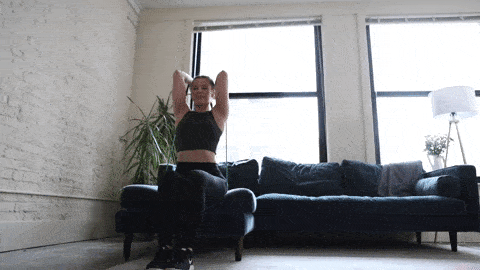
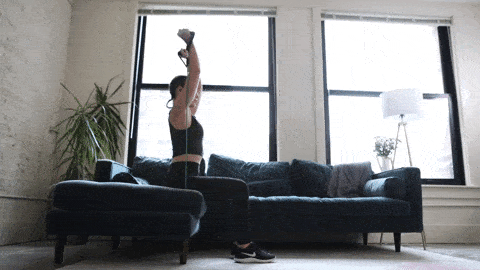 Sitting on a chair, place the middle of the band beneath your bum. Hold one handle in each hand and stretch your arms overhead. Bend at your elbows roughly 90 degrees or until your hands are near the back of your neck. Turn your palms so they’re facing upward and press through your elbows until your arms are completely extended. Return them to the starting position behind your neck and repeat.
Sitting on a chair, place the middle of the band beneath your bum. Hold one handle in each hand and stretch your arms overhead. Bend at your elbows roughly 90 degrees or until your hands are near the back of your neck. Turn your palms so they’re facing upward and press through your elbows until your arms are completely extended. Return them to the starting position behind your neck and repeat.
Side Plank With Row
Targets: Full Body
Reach For: A Compact Band
Rep + Set Scheme: 2 to 4 sets of 12 to 15 reps per side
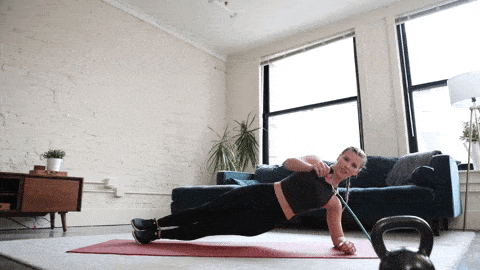 Position yourself in a side plank with the band secured under or around a stable object. Your back should be straight and your core, glutes, and quadriceps should be engaged. With on forearm planted firmly on the ground, hold one handle of the band in the opposite hand. Begin with your hand by your hip. When you’re ready, extend your arm fully, then draw back through the elbow, returning to your starting position. Repeat.
Position yourself in a side plank with the band secured under or around a stable object. Your back should be straight and your core, glutes, and quadriceps should be engaged. With on forearm planted firmly on the ground, hold one handle of the band in the opposite hand. Begin with your hand by your hip. When you’re ready, extend your arm fully, then draw back through the elbow, returning to your starting position. Repeat.
Additional Benefits of the Band
Women who are working toward enhancing their functional strength with resistance bands create specific conditions that help their bodies respond to several key forces. According to Schmitz, the ascending resistance of a band and its extreme portability “decrease the effects of gravity, reduce ground reaction forces, and slow down the forces of momentum.” Addressing these factors is crucial for achieving movement, strength, fat loss, muscle development, and performance objectives. It’s also extremely important when an individual has to rehabilitate a weakened or injured area of her body. With the assistance of an appropriate band, she is able to perform any movement successfully while decreasing the possibility of joint trauma. When using resistance bands, the body’s stabilizing muscles are supported in responding to balance and coordination demands at a level they can adequately handle. This advantage varies distinctly from free weights in that weights are gravity-dependent and may contribute to joint compression. Resistance bands can utilize vertical, horizontal, and even rotational forces, but with far less compression. This is important for overall musculoskeletal health because the various resistance vectors engaged during resistance band workouts prevent certain muscles and joints from being repetitively stressed along the same path or pattern of movement. For example, instead of performing traditional back squats several times a week, banded front squats can be incorporated as a substitute. As a result, the possibility of overuse injuries and joint trauma decreases. While this is important for anyone who exercises regularly, it’s especially important for those with preexisting joint concerns. If a specific body part has already undergone trauma, preventing further damage is critical. Schmitz also believes the variability of the resistance band eliminates compensatory habits. Individuals can immediately increase or decrease the resistance of their band depending on how they’re feeling. Thus, surrounding muscles do not have to be stressed in counteracting movements if fatigue sets in. Not only does this aid in injury prevention—it also maximizes training efficacy as it ensures the correct, targeted muscles are driving the movement.
Creativity at its Finest
We know how important consistency is when working toward health and fitness goals—however, there are many circumstances that seem to allow for an onslaught of excuses for not getting in the daily sweat sesh. Traveling across the country for a conference, visiting parents out of town, juggling a dozen to-do items with a car full of energetic kiddos—we understand. Luckily resistance bands appeal to your wellness drive by eliminating all of these excuses. They can accommodate anyone, anywhere, at any time. Between their portability, accessibility, and high level of versatility, resistance bands offer an endless selection of exercise options that can easily be tailored to any individual’s needs. From booty burners to rehabilitative treatment, the opportunities for varying resistance and postures are seemingly endless and nearly any movement can be replicated with a band to increase tension and target strength and mobility.


